|
|
 
Unit
Four - Script Analysis
Module 3: Blocking
Lesson 3 - Falls and Stage Fighting
Introduction:
Stage fighting is a controlled dance. It is rehearsed very slowly
until perfected, then brought up to speed. Acts of violence do
not occur on stage. Like all special effects, they only seem to
happen. Actors who do not have the self-discipline to work slowly
and methodically through stage fighting are not allowed to participate
the drama that requires it. Because the potential for physical
injury is high, the rules for stage combat must be followed at
all times.
 |
In
this lesson, actors will be introduced to the basics of stage
fighting. |
The
goal of stage combat is to create a good fight spectacle
while never hurting anyone. |
Activities:
This
section includes basic falls and taking hits. The next section
includes 3 types of hits. No weapons combat or throws are included.
Activity
1 - Falling:
Try each of the following falls after watching the animation.
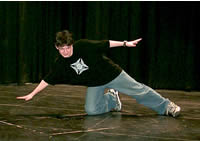 |
Side
Fall:
• like all falls, a side fall requires control and flexibility
• contact is made in the following order: knee, hip,
wrist, elbow, shoulder, back, head.
• The fall should be controlled and cushioned by each
point of contact
• the mat should be used to cushion the fall until the
technique is perfected. |
|
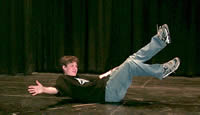
|
Rear
Fall and Roll:
•
contact is made in the following order: hands, elbows, shoulders
(wit head tucked to one side), knees, feet
the fall occurs directly back, with the hands breaking the
fall
• the momentum of the fall is used, as the actor reclines,
to tuck and do a backwards shoulder roll
• the fall should be controlled and cushioned by each
point of contact
• the mat should be used to cushion the fall until the
technique is perfected. |
|
|
|
Front
Fall:
• practicing the fall should be started on the knees
• fall forwards, and use your hands to catch you and
lower you to the floor (like a push-up)
• be sure wrists and elbows are bent
• keep practicing from increasing heights: squat, crouch,
standing
• substantial upper body strength is required for a standing
front fall
• the mat should be used to cushion the fall until the
technique is perfected. |
 |
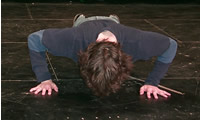 |
| After
completing the basic falls, discuss what you have learned
about how to do them well. Each actor should demonstrate his
or her best fall. |
 |
 |
When
falling, always keep limbs ready and bent at joints.
Falls cannot be absorbed well when limbs are rigid or flailing.
|
Receiving
a hit to the stomach or groin
• establish a point of contact
• the hit will cause a movement that is first up, then
back
place hands to catch the object used to make the hit (hand,
foot, weapon)
• the object used to create the hit makes very minimal
contact, and only if necessary
• practice the hit a minimum of five times in very slow
motion before speeding up |
 |
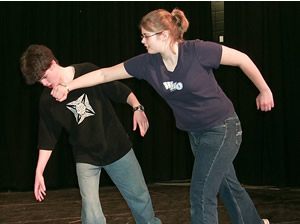 |
Receiving
a hit to the head
• establish the point of contact
• the hit will cause a movement that continues the motion
of the hit, then propelled the person back
• the hand or fist that hits does not make contact
• practice the hit a minimum of five times in very slow
motion before speeding up |
|
|
|
|
|
|
|
Activity
2 - Hitting:
Try each of the following attacks after watching the animation.
The
Slap:
• A slap is rehearsed slowly, and the hand just misses
contact with face by 5 cm. If a partner failed to turn turn
his or her head, the slap would make contact.
• lift hand up and back
• swing at a consistent height and direction in slow
movements, while the partner turn his or her face to follow
the movement.
• exaggerate the follow through to imply great effort
• this is repeated many times until perfected, then speed
is gradually increased |
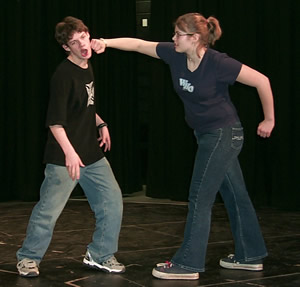 |
The
Punch:
• leave a large space between the combatants so the aggressor
can step into the blow
• take one step forward and swing across the chin with
the fist
• swing at a consistent height and direction in slow
movements, while the partner turn his or her face to follow
the movement
open the hand at the last moment and connect palm to shoulder
to create a push. Do this gently and avoid contact with the
collar bone
• exaggerate the follow through to imply great effort
• this is repeated many times until perfected, then speed
is gradually increased |
Knee
in the stomach:
• the aggressor places his or her hands on the shoulders
of the defender
• the aggressor lifts a knee slowly as the defender pulls
his or her hands in front of the stomach to catch the knee
• the defender uses the hold on the knee to push him
or herself up and then back as the attacker lets go of the
shoulders
• this is repeated many times until perfected, then speed
is gradually increased |
 |
 |
•
When completing any movement, use the body of one of the combatants
to mask the lack of contact with the audience.
• To make a sequence more interesting,
add grunts of exertion and cries of pain |
|
|
|
|
Evaluation:
At this stage, the teacher will likely evaluate the process
informally.
Next
Lesson / Previous Lesson
|
|
|
















